







This is the full version of the article. Click here to return to the blog's home page.
Everyone's a Winner: The 2017 Solar Eclipse
Photographing the Great American Eclipse of 2017 from central Oregon
Entry 18: September 9, 2017
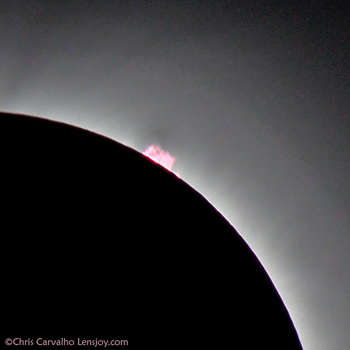 |
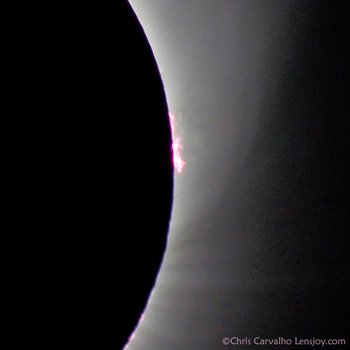 |
Depending on who you talked to, the 2017 solar eclipse ranged from a spiritual experience to the media event of the century, or possibly Armageddon. What you wanted to see in it, you found, much like a Rorschach test given to millions of people at the same time. For me, it was the chance of a lifetime and not to be missed. We made reservations a year in advance for a motel in Redmond, Oregon so we could be within the path of totality as Portland is just outside it. Already rooms were getting hard to find. By June we heard all kinds of dire predictions of fuel shortages, traffic jams, food stores and restaurants selling out, cell phone outages, and power failures. Newspapers said that over one million tourists would visit Oregon for the event, causing unprecedented strain on communities fortunate enough to be in the darkest part of the moon's shadow for one or two brief minutes.
We extended our hotel stay to arrive on Saturday, two days early just for good measure, and leave the day after, a Tuesday. Some people who made early reservations at low rates found their rooms were cancelled to be resold at inflated prices, as high as $500 per night due to the high demand. Fortunately, the state government stepped in and ruled it was an illegal practice.
About two weeks before our trip, I realized it might already be too late to make restaurant reservations for dinner. Fortunately, it was possible to find three very good places to eat in Bend, Oregon, about a half hour from our hotel. This was the first hint that the media predictions of "apoc-eclipse" might not come to pass. With a nice dinner awaiting us every evening, we felt a bit less panicked.
Doing advance research is key to learning how to make good photos of the eclipse. I won't share all the details as the experts have done that already. Here are a few tips based on what I learned from the experience. The basics are to have a good telephoto lens with image stabilization, a solar filter to protect your eyes, the lens and camera, and to bring the exposure into a manageable range, a good tripod, and number 14 welder's glass for looking at the sun. The welder's glass provides much better quality than paper eclipse glasses with plastic film filters, and it's reliably safe.

Bob with his dorky eclipse glasses, essential for safety | |
We scouted a viewing site on Saturday after much time spent studying maps of the area. We wanted to stay off of major highways because they might have traffic backups that could keep us from getting to our destination on time. It had to be north of the hotel to give us the longest possible time in totality. After finding a good spot, we had a nice dinner and had a chance to wind down from the long trip and worries about problems that looked unlikely now.
On Monday, we left the hotel around 6 am and drove north. Smoke from wildfires was very thick on Sunday, and still was worrisome when we left. As we drove north it got better. But closer to our viewing spot, the smoke thickened. Driving further north would get us more time in the totality phase of the eclipse, but risk poorer viewing conditions. So we decided to turn onto a side road and by luck alone found a great spot on a cliff overlooking the Crooked River canyon. Only a few cars were parked there. We joined them and I set up the camera.
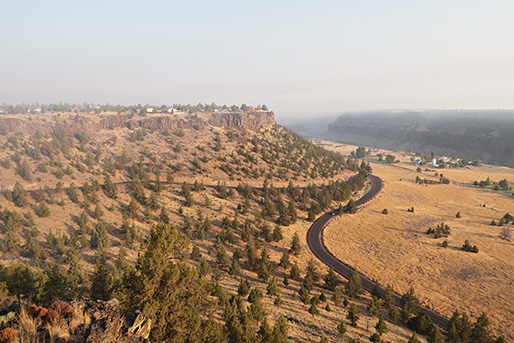
Looking north towards Madras from our viewing site above the
Crooked River
Everyone was having a great time. I had wonderful conversations with several people and there was lots of interest in my camera gear. As the moon began to enter the partial eclipse phases, I shot an image every ten minutes. Sunspots were clearly visible on the sun's disk. As it got darker, a light east wind picked up, clearing away most of the smoke. It might have been a blessing from above, but experts also say that sudden cooling from the moon's shadow can create wind. Coyotes howled in the canyon below, thinking it was dusk. The air got chilly, and excitement rose in anticipation. Finally, only a narrow crescent of light remained and we could see Mt. Hood to the north of us, outside the band of totality, was still lit up as we entered darkness.

The crowd setting up for the eclipse
Totality is an emotional and chaotic moment, and passes by quickly. Even though I had rehearsed the sequence of shots I wanted to take, I missed photographing the first diamond ring phase because it went by so fast and I was staring skyward in a state of awe. I did get a series of corona exposures done though, amidst the hoots and cheers of the crowd. My view of the corona wasn't the best because I was wearing prescription sunglasses and forgot to have my regular glasses handy to switch to at the last moment. The camera would have to see it for me.
At our spot there was about a minute and a half of totality time, but it seemed much shorter. I did try to get a shot of the second diamond ring, and succeeded. Back in brighter light with the final partial phases, I had time to review the corona shots and noticed some beautiful solar flares. Many in the crowd stopped by to see the result on the camera's screen.
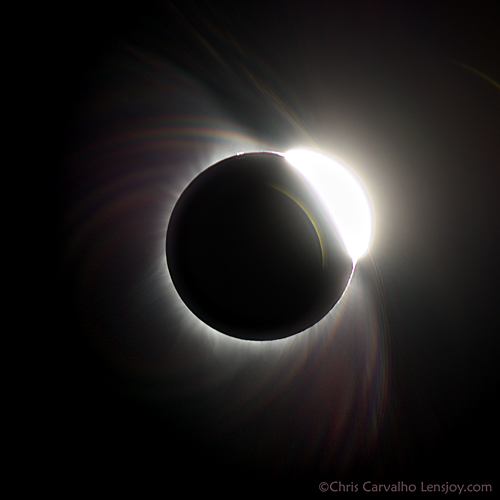
The diamond ring of the 2017 solar eclipse
The photo below is a composite of three exposures allowing a view of the inner, middle, and outer corona. A single exposure can't capture the range of brightness that the human eye can see. I'm quite pleased with the result and hope you enjoy it too. I'll have another composition to share soon that includes all the partial phases and totality in one image.
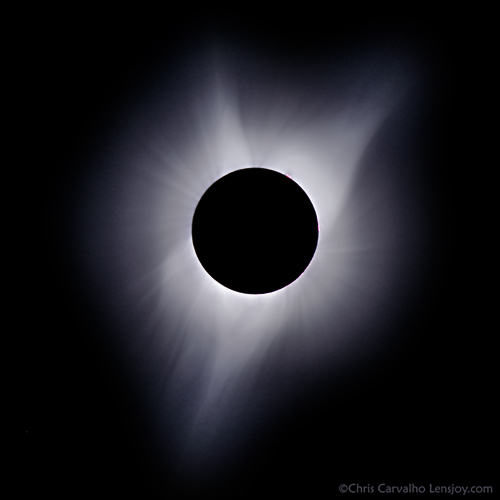
View of the corona at totality
What was totality like? It was dark, but we were surrounded in all directions by dim light at the horizon, unlike a sunrise or sunset. Everyone was gasping at the dark moon above, surrounded by the shimmering corona. It was like being at a sports match where your team just scored and won, but we were all looking skyward. Instead of there being a loser, everyone was a winner. That's a rare happening in our world. For a moment, we were all focused on the heavens and the great forces we take for granted each day. It was a chance to put away our worries and self-centered thoughts for a while and let nature take center stage.
Photography means so much to me for that reason. It takes me away from day-to-day worries and focuses attention on what's going on around me in nature. We can all benefit from a chance to set aside our thoughts and take more time to watch and wonder.
What I felt at the moment was simple, humbling awe. After living 58 years I've seen just about everything I had thought. Yet here was something new, fantastic, and incredible. Each passing second was different from the one before, and wouldn't be repeated. I wanted so much to go back and see it again.
The most important thing I learned from the experience is that while it may be possible for one person to get good photos of all stages of the eclipse, it would only come with practice from going to several of them. A much better strategy is to have a team of people, and have each person focus on a particular part of the eclipse. That way, there is less chance for error, minimal fiddling with the camera's setup, and no time lost trying to make multiple adjustments.
The other realization is not to listen to the naysayers. Predictions of crowds causing serious problems are overly pessimistic. What typically happens is that local residents stay off the roads during the event, meaning that there's additional capacity to handle visitor traffic. Traffic problems were minimal, especially if arriving a day or two early and staying an extra day afterward. Prepare, but don't overthink things. The next time there's an eclipse, just go and you'll likely have a special experience of a lifetime. Hang out at your viewing spot, sit back with new friends, and let the heavens put on a show.
Chris Carvalho has a Bachelor of Science degree in chemical engineering from the University of California at Berkeley. He is a photographer and blogger on public policy, environmental, and conservation topics.
